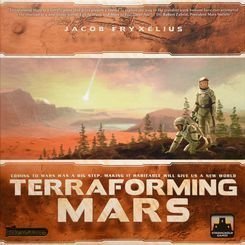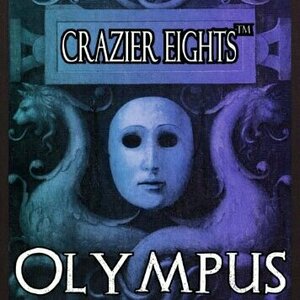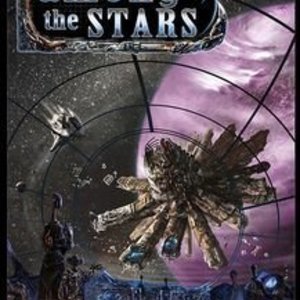Search
Search results
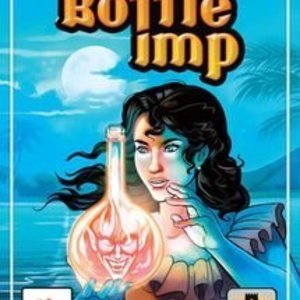
The Bottle Imp
Tabletop Game
In this trick-taking game based on the short story by Robert Louis Stevenson of the same name, the...
Cardgames TricktakingGame GatewayGames
Fred (860 KP) rated Terraforming Mars in Tabletop Games
Mar 6, 2018
Good game, with one major flaw. The victory points on the cards. See, I've played 4 games of this so far (and one solo) & each time, the victory came due to whoever had the most victory points with their cards. Nothing else mattered. No matter the strategy, no matter the milestones or awards. It was the cards. And here's the problem with that. Getting cards with victory points is luck. You either get them or you don't. First game I played, I didn't even pay attention. I was well ahead of one player, and a few behind the leader. Then, the player in last counted his victory points on the cards & zoomed ahead, winning by at least 10 points. Must have had near to 30 points in cards alone.
Second game, I played against my wife & went for the cards & easily won.
Third game, I played against 4 players & again went for the cards. I got a lot of them & won the game easily. My friend, who had won the first game, said, "I was trying to get the cards with victory points, but I hardly got any. I played every one I got & only got a few points."
Fourth game. Played with my brother, his wife & my wife. Everyone played well, & we were pretty much even along the TR line. I got 3 of the milestones, giving me 15 victory points at the end of the game, which made my brother exclaim that it wasn't fair because he was going to get them, but each time, I went before him in the generation & that those 15 points would win me the game. He grabbed 3 of the awards, but only scored 12 points, while I scored 2 more points & my wife scored 7 points. Scoring for greenery, I got another 7 points. I was well ahead & thought victory was mine. We then started to count the points on our cards. As I was counting, I glanced up to see my brother moving his score cube past mine...way past mine. I thought that he must be cheating & he assured me that he had all these points. I looked at his cards & he had indeed all the points he said. I counted my points. 4. 4 points. What happened to my friend last game, had happened to me. I played every card I got that gave victory points & got 4 points. Actually, I had one more card that would have given me 3 more points, but I needed to already have a card that had a bacteria tag on it. But again, with the luck of the draw, I never got one to play, the entire game.
Now, there's nothing wrong with luck in games. I mean, every dice game is all luck. Every card game, is mostly luck. There is some strategy to the game, but it's basically play what you can to improve. And most people can figure this out & keep the game even. But with this game, every winner has won by at least 10 points & each has won with the points on cards alone.
While this may break a game for some people, I still find the game fun to play. I like the theme & I like the components. Even though the cards are thin & the ME(money) cubes are already flaking, I still like them. The luck factor is good in a way, as it means that one person can't be ridiculously good at the game & win every time. But this is not for everyone. My friend is very competitive & only wants to win. He's the kind of guy that goes online to find strategies on how to win, uses them, wins every game & thus ruins the game for everyone but him.
My bottom line is I like the game. It is one of my current favorites. The solo game is very good too. It's fairly quick, compared to the multi-player game. Less than half the time of the full game. I do recommend it to players who don't care too much about winning every game. You're not going to. Get used to it. Even though this is a major flaw for some, I'm still giving it 7 out of 10 for fun.
Second game, I played against my wife & went for the cards & easily won.
Third game, I played against 4 players & again went for the cards. I got a lot of them & won the game easily. My friend, who had won the first game, said, "I was trying to get the cards with victory points, but I hardly got any. I played every one I got & only got a few points."
Fourth game. Played with my brother, his wife & my wife. Everyone played well, & we were pretty much even along the TR line. I got 3 of the milestones, giving me 15 victory points at the end of the game, which made my brother exclaim that it wasn't fair because he was going to get them, but each time, I went before him in the generation & that those 15 points would win me the game. He grabbed 3 of the awards, but only scored 12 points, while I scored 2 more points & my wife scored 7 points. Scoring for greenery, I got another 7 points. I was well ahead & thought victory was mine. We then started to count the points on our cards. As I was counting, I glanced up to see my brother moving his score cube past mine...way past mine. I thought that he must be cheating & he assured me that he had all these points. I looked at his cards & he had indeed all the points he said. I counted my points. 4. 4 points. What happened to my friend last game, had happened to me. I played every card I got that gave victory points & got 4 points. Actually, I had one more card that would have given me 3 more points, but I needed to already have a card that had a bacteria tag on it. But again, with the luck of the draw, I never got one to play, the entire game.
Now, there's nothing wrong with luck in games. I mean, every dice game is all luck. Every card game, is mostly luck. There is some strategy to the game, but it's basically play what you can to improve. And most people can figure this out & keep the game even. But with this game, every winner has won by at least 10 points & each has won with the points on cards alone.
While this may break a game for some people, I still find the game fun to play. I like the theme & I like the components. Even though the cards are thin & the ME(money) cubes are already flaking, I still like them. The luck factor is good in a way, as it means that one person can't be ridiculously good at the game & win every time. But this is not for everyone. My friend is very competitive & only wants to win. He's the kind of guy that goes online to find strategies on how to win, uses them, wins every game & thus ruins the game for everyone but him.
My bottom line is I like the game. It is one of my current favorites. The solo game is very good too. It's fairly quick, compared to the multi-player game. Less than half the time of the full game. I do recommend it to players who don't care too much about winning every game. You're not going to. Get used to it. Even though this is a major flaw for some, I'm still giving it 7 out of 10 for fun.
Purple Phoenix Games (2266 KP) rated Crazier Eights: Olympus in Tabletop Games
Feb 25, 2020
War. Old Maid. Go Fish. Crazy Eights. These are classic card games we probably all grew up playing. There have been many re-themes and new difficulty layers spread upon them to make them even more interesting. While UNO certainly has cornered the market on the Crazy Eights base, we have a new contender: Crazier Eights. Recoculous has published several versions of this card game with different themes: Camelot, Avalon, One Thousand & One Nights, and Shahrzad. Today we are taking a preview of Crazier Eights: Olympus.
You HAVE played Crazy Eights right? The card game where you attempt to be the first to exhaust your hand of cards, but you can only play down if you can match the suit or number on top of the discard pile? And if you can’t, you throw down an 8 as a wild and call the color to be played next? Well there you have the easy rules. Crazier Eights: Olympus (which I will from here call C8O) holds basically the same rule-set with a few new mechanics and a theme. The win condition is still the same: be the first to exhaust your hand of cards, but to win you will need to play your hand strategically against your opponents.
DISCLAIMER: We were provided a prototype copy of this game for the purposes of this review. These are preview copy components, and I do not know for sure if the final components will be any different from these shown. Also, it is not my intention to detail every rule in the game. You are invited to back the game through the Kickstarter campaign, or purchase it through any retailers stocking it after fulfillment. -T
To setup, shuffle the large deck of cards and place the deck in the middle of the table. Flip the top card to begin the discard pile and dictate the first card play. Deal each player seven cards and you are ready to begin!
The turn structure is familiar: check for any “start of turn” effects and apply them, draw a card, play and/or discard a card, then resolve any “end of turn” effects. The deck is comprised of Events and Assets in different colors (suits) and numbers like in a typical deck of playing cards. After checking and resolving start of turn effects on Asset cards in your personal tableau, you must draw a card from the deck. This is where C8O strays from OG Crazy Eights a bit. You may play a card from your hand (Assets and Events) and discard a card to the discard pile (matching the suit/number/or an Eight), or simply play a card from your hand without discarding. Cards played from your hand can be Event cards that are played, resolved, and then discarded to the bottom of the discard pile, or an Asset card that is played to your tableau that cause chain reactions or other abilities on future turns. Next, resolve any end of turn effects from Assets in your tableau before the next player begins their turn.
Play continues in this fashion until one player has rid themselves of their hand and is crowned the Master of Olympus! Or at least, the winner of the game.
Components. This game is a box full of cards. Again, as I do not know if these components will be altered at all, I will comment on what we were provided. The cards are fine. The layout makes sense, and the art on the faces of the cards remind me of very classic art depicting ancient Grecian scenes. I am no art historian, so I do not know if they are existing art pieces or new ones crafted for this game, but either way, they are a joy to behold… if you can spend the time appreciating the art instead of tracking what cards you need to play and what effects you can chain together (that was me). Extra points to the Recoculous team for associating symbols with the different suit colors for our colorblind friends. This is something that unfortunately goes unaddressed far too often.
This implementation is the first Crazier Eights we have had the chance to try, and I can say that we really enjoyed our plays of it. The game comes with many interesting and varied effects to craft an ingenious strategy, and the art is stellar. Beware of playing with AP-prone gamers, as there is a lot going on and it is more than just a skinned Crazy Eights. However, now having played this several times, I can say that it is my favorite Crazy Eights derivative and certainly worthy of a look. If your game collection is sorely lacking in ancient Greek-themed card games, or if you want a hybrid game of old school rules with interesting twists, then do consider backing this one or purchasing one of its predecessors.
PS – Don’t worry if, while you are playing, you have all your Assets stolen or destroyed. I have won the game with zero Assets in front of me while opponents have had eight, ironically. Assets are great, but you still need to shed your hand.
You HAVE played Crazy Eights right? The card game where you attempt to be the first to exhaust your hand of cards, but you can only play down if you can match the suit or number on top of the discard pile? And if you can’t, you throw down an 8 as a wild and call the color to be played next? Well there you have the easy rules. Crazier Eights: Olympus (which I will from here call C8O) holds basically the same rule-set with a few new mechanics and a theme. The win condition is still the same: be the first to exhaust your hand of cards, but to win you will need to play your hand strategically against your opponents.
DISCLAIMER: We were provided a prototype copy of this game for the purposes of this review. These are preview copy components, and I do not know for sure if the final components will be any different from these shown. Also, it is not my intention to detail every rule in the game. You are invited to back the game through the Kickstarter campaign, or purchase it through any retailers stocking it after fulfillment. -T
To setup, shuffle the large deck of cards and place the deck in the middle of the table. Flip the top card to begin the discard pile and dictate the first card play. Deal each player seven cards and you are ready to begin!
The turn structure is familiar: check for any “start of turn” effects and apply them, draw a card, play and/or discard a card, then resolve any “end of turn” effects. The deck is comprised of Events and Assets in different colors (suits) and numbers like in a typical deck of playing cards. After checking and resolving start of turn effects on Asset cards in your personal tableau, you must draw a card from the deck. This is where C8O strays from OG Crazy Eights a bit. You may play a card from your hand (Assets and Events) and discard a card to the discard pile (matching the suit/number/or an Eight), or simply play a card from your hand without discarding. Cards played from your hand can be Event cards that are played, resolved, and then discarded to the bottom of the discard pile, or an Asset card that is played to your tableau that cause chain reactions or other abilities on future turns. Next, resolve any end of turn effects from Assets in your tableau before the next player begins their turn.
Play continues in this fashion until one player has rid themselves of their hand and is crowned the Master of Olympus! Or at least, the winner of the game.
Components. This game is a box full of cards. Again, as I do not know if these components will be altered at all, I will comment on what we were provided. The cards are fine. The layout makes sense, and the art on the faces of the cards remind me of very classic art depicting ancient Grecian scenes. I am no art historian, so I do not know if they are existing art pieces or new ones crafted for this game, but either way, they are a joy to behold… if you can spend the time appreciating the art instead of tracking what cards you need to play and what effects you can chain together (that was me). Extra points to the Recoculous team for associating symbols with the different suit colors for our colorblind friends. This is something that unfortunately goes unaddressed far too often.
This implementation is the first Crazier Eights we have had the chance to try, and I can say that we really enjoyed our plays of it. The game comes with many interesting and varied effects to craft an ingenious strategy, and the art is stellar. Beware of playing with AP-prone gamers, as there is a lot going on and it is more than just a skinned Crazy Eights. However, now having played this several times, I can say that it is my favorite Crazy Eights derivative and certainly worthy of a look. If your game collection is sorely lacking in ancient Greek-themed card games, or if you want a hybrid game of old school rules with interesting twists, then do consider backing this one or purchasing one of its predecessors.
PS – Don’t worry if, while you are playing, you have all your Assets stolen or destroyed. I have won the game with zero Assets in front of me while opponents have had eight, ironically. Assets are great, but you still need to shed your hand.
Purple Phoenix Games (2266 KP) rated Among the Stars in Tabletop Games
Dec 3, 2021
If there is a mechanic that we at Purple Phoenix Games seem to really love, it is card drafting. One such game that has been a big hit for us (well, at least for 3 of us….) is 7 Wonders. Draft a card, pass the rest to your neighbor, draft another card from those received from your other neighbor, and repeat. Set in the Ancient World, you are working to build the most wondrous city. But Laura, why all the 7 Wonders talk in this review? Well, because Among the Stars gives me major 7 Wonders vibes, but IN SPACE. Keep reading to see what I mean.
Disclaimer: Among the Stars can be played in two different modes – Aggressive and Non-Aggressive. This review covers the core game Non-Aggressive mode of play. -L
Among the Stars is a game of card drafting and tile placement in which players take on the roles of different alien races attempting to build the most efficient space station over the span of 4 years (rounds). After the 4th and final round, players calculate their final scores, and the player with the highest score is the winner! To setup for a game, assemble the Location deck as described in the rules. Each player takes a Main Reactor card and score marker in their chosen color. Score markers are placed at zero on the score board, and players put their Main Reactor card face-up in front of them, along with 2 Energy Cubes. Players choose, or are randomly given, a Race Tile with a special Racial Ability to be used throughout the game. Randomly draw the requisite number of Objective cards and put them face-up near the score board. The game is now ready to begin!
Over the course of 4 rounds, players will be drafting cards and playing them into their Space Station. At the start of each round, every player collects 10 Credits (game currency), and draws a hand of 6 Location cards. Every turn, players will select one card from their hand, place it face-down in front of them, and will pass the remaining cards in their hand to the next player (in either clockwise or counter-clockwise direction, depending on the round). Players will then simultaneously reveal their chosen card and perform one of three actions: Build a Location, Build Power Reactor, or Discard and gain 3 Credits. To Build a Location, you pay its listed cost in Credits and/or Energy and add it to your Space Station. Locations must be placed orthogonally adjacent to an existing Location. When you build a Location, you immediately gain the listed number of VP (tracked on the score board), and may use its ability. Some abilities are immediate and earn you extra VP now, while some are delayed and will be counted at the end of the game. To Build a Power Reactor, you will first discard your selected card for the turn. Pay the 1 Credit cost of a Power Reactor and place it into your Space Station, along with 2 Energy Cubes. Every round, you get 10 Credits, but Energy Cubes do not replenish unless you build more Power Reactors, so keep an eye on your resources! The last possible action is to Discard and gain 3 Credits, and is pretty self-explanatory.
Players continue taking turns (drafting cards, passing cards, and playing cards) until they are left with no cards in hand. The round is now over. Move the round marker to the next space, and begin a new round by drawing another hand of 6 cards. After the 4th round of play, the game ends and final VP are scored. Victory Points have been earned throughout the game, but now any delayed abilities are triggered and scored, Objective points are added, and players gain points for Power Reactors and remaining Credits. The player with the highest score is the winner!
See what I mean about being 7 Wonders in space? The overall gameplay is pretty much the same thing – draft a card, pass cards, play the card – even though thematically they’re on opposite ends of time. That familiarity and simplicity of the gameplay definitely added to my enjoyment of the game. And when I say ‘simplicity’ of gameplay, I do not mean that it is an easy game necessarily. It still requires a decent amount of strategy! Not only do you have to decide what card to draft for maximum benefit, but you also need to figure out exactly where to put it in your Space Station too. Some Locations may give you extra VP for being adjacent to certain other Locations, or they may even earn more VP for distance between two Locations. You’ve got to be thinking in advance, but also able to adapt on the fly. Do you draft a card that you don’t necessarily want because you can see your opponent needs it? Or do you keep your head down and try to fly under the radar? The strategy and mechanics work very well together in creating an engaging and entertaining game.
Components. This game basically just consists of cards, a score board, and some tokens. So even though it’s nothing too fancy or anything, they’re still pretty decent quality! The artwork is thematic and fun to look at, and the layout of the cards is easy to understand. The cards are square, so that makes for some interesting shuffling, but the square shape really lends itself well to the tile-laying aspect of the gameplay. So all in all, good production quality. Just be warned – as the game progresses, it turns into quite a table hog, since you are constantly adding cards to your Space Station. Not a knock on the game, just a heads up so you give yourself plenty of room!
Will Among the Stars replace 7 Wonders for me? Ultimately, no. Don’t get me wrong, it’s still a great game, but 7 Wonders just offers a little more strategy that bumps it to a higher level than Among the Stars. To introduce players to these mechanics and gameplay style, I would use Among the Stars because it is a little ‘lighter’ than 7 Wonders, if you ask me. If you are a fan of 7 Wonders and are interested in a more futuristic theme, I would definitely recommend checking out Among the Stars. It’s a neat game that has been hiding on my game shelf without the playtime it deserves. Purple Phoenix Games gives this one a stellar 15 / 18.
Disclaimer: Among the Stars can be played in two different modes – Aggressive and Non-Aggressive. This review covers the core game Non-Aggressive mode of play. -L
Among the Stars is a game of card drafting and tile placement in which players take on the roles of different alien races attempting to build the most efficient space station over the span of 4 years (rounds). After the 4th and final round, players calculate their final scores, and the player with the highest score is the winner! To setup for a game, assemble the Location deck as described in the rules. Each player takes a Main Reactor card and score marker in their chosen color. Score markers are placed at zero on the score board, and players put their Main Reactor card face-up in front of them, along with 2 Energy Cubes. Players choose, or are randomly given, a Race Tile with a special Racial Ability to be used throughout the game. Randomly draw the requisite number of Objective cards and put them face-up near the score board. The game is now ready to begin!
Over the course of 4 rounds, players will be drafting cards and playing them into their Space Station. At the start of each round, every player collects 10 Credits (game currency), and draws a hand of 6 Location cards. Every turn, players will select one card from their hand, place it face-down in front of them, and will pass the remaining cards in their hand to the next player (in either clockwise or counter-clockwise direction, depending on the round). Players will then simultaneously reveal their chosen card and perform one of three actions: Build a Location, Build Power Reactor, or Discard and gain 3 Credits. To Build a Location, you pay its listed cost in Credits and/or Energy and add it to your Space Station. Locations must be placed orthogonally adjacent to an existing Location. When you build a Location, you immediately gain the listed number of VP (tracked on the score board), and may use its ability. Some abilities are immediate and earn you extra VP now, while some are delayed and will be counted at the end of the game. To Build a Power Reactor, you will first discard your selected card for the turn. Pay the 1 Credit cost of a Power Reactor and place it into your Space Station, along with 2 Energy Cubes. Every round, you get 10 Credits, but Energy Cubes do not replenish unless you build more Power Reactors, so keep an eye on your resources! The last possible action is to Discard and gain 3 Credits, and is pretty self-explanatory.
Players continue taking turns (drafting cards, passing cards, and playing cards) until they are left with no cards in hand. The round is now over. Move the round marker to the next space, and begin a new round by drawing another hand of 6 cards. After the 4th round of play, the game ends and final VP are scored. Victory Points have been earned throughout the game, but now any delayed abilities are triggered and scored, Objective points are added, and players gain points for Power Reactors and remaining Credits. The player with the highest score is the winner!
See what I mean about being 7 Wonders in space? The overall gameplay is pretty much the same thing – draft a card, pass cards, play the card – even though thematically they’re on opposite ends of time. That familiarity and simplicity of the gameplay definitely added to my enjoyment of the game. And when I say ‘simplicity’ of gameplay, I do not mean that it is an easy game necessarily. It still requires a decent amount of strategy! Not only do you have to decide what card to draft for maximum benefit, but you also need to figure out exactly where to put it in your Space Station too. Some Locations may give you extra VP for being adjacent to certain other Locations, or they may even earn more VP for distance between two Locations. You’ve got to be thinking in advance, but also able to adapt on the fly. Do you draft a card that you don’t necessarily want because you can see your opponent needs it? Or do you keep your head down and try to fly under the radar? The strategy and mechanics work very well together in creating an engaging and entertaining game.
Components. This game basically just consists of cards, a score board, and some tokens. So even though it’s nothing too fancy or anything, they’re still pretty decent quality! The artwork is thematic and fun to look at, and the layout of the cards is easy to understand. The cards are square, so that makes for some interesting shuffling, but the square shape really lends itself well to the tile-laying aspect of the gameplay. So all in all, good production quality. Just be warned – as the game progresses, it turns into quite a table hog, since you are constantly adding cards to your Space Station. Not a knock on the game, just a heads up so you give yourself plenty of room!
Will Among the Stars replace 7 Wonders for me? Ultimately, no. Don’t get me wrong, it’s still a great game, but 7 Wonders just offers a little more strategy that bumps it to a higher level than Among the Stars. To introduce players to these mechanics and gameplay style, I would use Among the Stars because it is a little ‘lighter’ than 7 Wonders, if you ask me. If you are a fan of 7 Wonders and are interested in a more futuristic theme, I would definitely recommend checking out Among the Stars. It’s a neat game that has been hiding on my game shelf without the playtime it deserves. Purple Phoenix Games gives this one a stellar 15 / 18.

The Spiel - MP3 Version
Podcast
The Spiel is a show about games and the people who love them. Each episode, we review and discuss a...
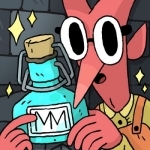
Miracle Merchant
Games and Entertainment
App
Miracle Merchant is a solitaire style potion brewing card game. In Miracle Merchant you become the...
Lee (2222 KP) rated Exploding Kittens in Tabletop Games
Aug 31, 2018
Fun Game
My daughter is in love with this bonkers game! Exploding Kittens is a russian roulette style game featuring amusing art from The Oatmeal. Simple to learn, but with some quirky little rules that I have to keep looking up again and again (usually when my daughter uses them on me to full effect!). It's one of those games that isn't that exciting at the beginning of a new game, but as you near the end of the pack and you know that the exploding kitten card is coming soon, the tension and enjoyment really grows. I'm not sure of the longevity of the game though, and that's the only downside to this really. There are expansion packs available, to enhance the gameplay and increase the potential number of players, which I'd be interested to try out some time.
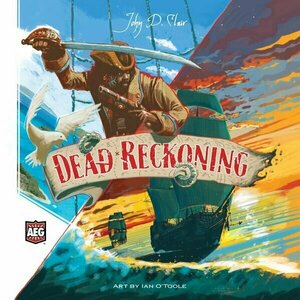
Dead Reckoning
Tabletop Game
Dead Reckoning is a game of exploration, piracy, and influence based in a Caribbean-esque setting....
RPGMP3 (211 KP) rated Joking Hazard in Tabletop Games
Apr 20, 2018
Cyanide and Happiness (1 more)
Can Be Really Funny
Some Good Games, Some Dull Games
I love Cyanide and Happiness. It is awesome. So I Kickstarted this game when it came out without any hesitation. The idea is pretty simple and similar to Cards Against Humanity with pictures. Everyone has seven cards. You draw one from the pile and play as the first card, the Judge plays another card either in front or behind the first card and then everyone else plays a card to complete the comic strip. Then the Judge decides who wins.
It can be totally hilarious and I have played games where my sides have hurt from laughing. I've even cried. Sadly, I have also had games where the images just don't work and nothing is funny and it is just a bit awkward as players try to play something and fail.
That being said, it is an easy beer and pretzels game that does what it sets out to do reasonably well. If you love Cyanide and Happiness and are willing to take the risk of some dull rounds (or even whole games) then it is definitely worth adding to your collection for those games where everything just drops into place.
It can be totally hilarious and I have played games where my sides have hurt from laughing. I've even cried. Sadly, I have also had games where the images just don't work and nothing is funny and it is just a bit awkward as players try to play something and fail.
That being said, it is an easy beer and pretzels game that does what it sets out to do reasonably well. If you love Cyanide and Happiness and are willing to take the risk of some dull rounds (or even whole games) then it is definitely worth adding to your collection for those games where everything just drops into place.
